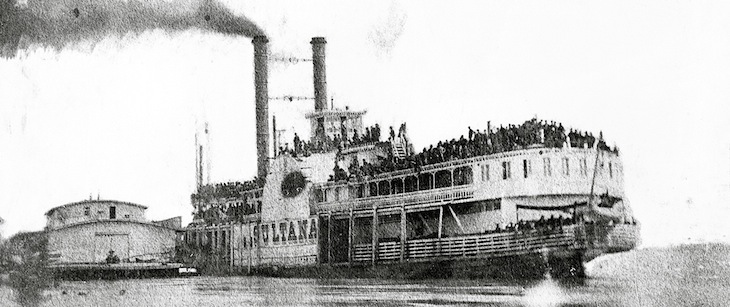Governor dedicates $750,000 toward building of Sultana museum in Marion
by April 27, 2021 3:29 pm 1,328 views

On April 27, 1865, the steamboat Sultana exploded on the Mississippi River about 7 miles from Memphis.
When the New York Times published its newspapers the last week of April 1865, there was a grand total of three lines dedicated to the Sultana, a steamship that sank in the fast-moving waters of the Mississippi River adjacent to Crittenden County.
The ship carried up to 2,000 passengers and most were Union prisoners of war that were headed home. An estimated 1,200 died on that night when the ship’s boilers exploded due to carrying six times as many people as it could carry.
It remains the single greatest loss of life in the maritime history of the United States. The boat still rests below a soybean field in the county. The incident was quickly forgotten and to this day is known by very few. An effort is underway to change that narrative.
Gov. Asa Hutchinson on Tuesday (April 27) dedicated $750,000 towards building a Sultana museum in Marion. He made the announcement at the proposed site for the museum that will cost an estimated $7.5 million. A fundraising campaign is now underway. A timetable for raising the money and building the museum has not been released.
“How can you understand the history of the Mississippi River without coming here to learn about the Sultana?” he said to a crowd of more than 100 people which included civic and business leaders.
During his remarks, Hutchinson noted the few lines that were dedidated to the disaster in the Times, but also gave it historical context. President Abraham Lincoln had been assassinated less than two weeks before and the nation was gripped by the pursuit of his killer, John Wilkes Booth.
“This has never gotten the historical attention it should have received,” Hutchinson said.
The future museum will commemorate and honor those who experienced the horrific disaster and preserve a piece of the nation’s history. The Sultana museum is forecasted to attract 50,000 visitors to Marion annually. Those tourists are projected to contribute over $3.5 million dollars in spending in the Delta Region.
The Sultana was a paddle-wheel steamboat commissioned in 1863 on the Mississippi River during the Civil War. It had a maximum capacity of 376 passengers. The boat ultimately ended up in Vicksburg, Miss., at the war’s close. The chief quartermaster at Vicksburg, Lt. Reuben Hatch, had a military past filled with corruption. He was from Illinois and had a powerful ally who secured his position at Vicksburg — President Abraham Lincoln.
Hatch was facing a court-martial tribunal for taking bribes during a stint as the quartermaster in Cairo, Ill. His brother O.M. Hatch was a financial backer and personal friend of Lincoln, and before the court-martial took place, the sitting president sent the judge a letter that ultimately led to the dismissal of charges. Hatch then made his way south.
The Sultana arrived in Vicksburg on April 23, 1865, just days after the war ended and Lincoln had been assassinated. Thousands of Union prisoners of war needed to be transported back to their homes. Many were sick and emaciated. Some were so weak they had to be carried onto the boat.
Greed compelled Hatch to place more than 2,000 soldiers on the Sultana instead of dividing the soldiers between it and other available transport boats. At Hatch’s behest, those efforts were refused. Loaded six times beyond its capacity wasn’t the only problem the Sultana faced. Her boilers were severely damaged and were in need of repair.
Despite those factors, the boat began the churn north at 9 p.m. in the flood-swollen river headed for Cairo. Three boilers exploded late at night three days later. The hot coals, scalding water and fire killed hundreds in the moments following the initial blast.
Marion residents and other boats along the river attempted to save soldiers who were thrown into the chaotic waters. According to history.net, a sailor aboard the U.S.S. Tyler wrote in the ship’s log: “Of all the sounds and noises I ever heard that was the most sorrowful; some cursing, calling for help; and shrieking. I will never forget those awful sounds.”
For many years, it was believed up to 1,800 soldiers were killed that night, making it a worse tragedy than the sinking of the Titanic in 1912. Recent research indicates the number is closer to 1,200, which means more were still killed on the Sultana than killed on the U.S.S. Arizona during the Dec. 7, 1941 attack on Pearl Harbor.
